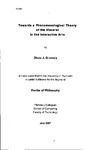Towards a Phenomenological Theory of the Visceral in the Interactive Arts
| dc.contributor.author | Gromala, Diane J. | |
| dc.contributor.other | Faculty of Science and Engineering | en_US |
| dc.date.accessioned | 2011-09-26T10:02:34Z | |
| dc.date.accessioned | 2013-10-23T11:07:39Z | |
| dc.date.available | 2011-09-26T10:02:34Z | |
| dc.date.available | 2013-10-23T11:07:39Z | |
| dc.date.issued | 2007 | |
| dc.identifier | Not available | en_US |
| dc.identifier.uri | http://hdl.handle.net/10026.1/653 | |
| dc.description | This is a digitised version of a thesis that was deposited in the University Library. If you are the author and you have a query about this item please contact PEARL Admin (pearladmin@plymouth.ac.uk) | |
| dc.description | Metadata merged with duplicate record (http://hdl.handle.net/10026.1/2319) on 20.12.2016 by CS (TIS). | |
| dc.description.abstract |
This thesis explores the ways in which certain forms of interactive art may and do elicit visceral responses. The term "visceral" refers to the cardiovascular, respiratory, uro-genital and especially excretory systems that affect mind and body on a continuum of awareness. The "visceral" is mentioned in the field of interactive arts, but it remains systematically unexplored and undefined. Further, interactive artworks predominantly focus on the exteroceptive (stimuli from outside) rather than the interoceptive (stimuli arising within the body, especially the viscera) senses. The existentialist phenomenology of Maurice Merleau-Ponty forms the basis for explorations of the visceral dimension of mind/body. New approaches to understanding interactive art, design and the mind/body include: attunements to the world; intertwinings of mind/body, technology and world; and of being in the world. Each artwork within utilizes a variation of the phenomenological methods derived from Merl eau-Ponty's; these are discussed primarily in Chapters One and Three. Because subjective, first-person, experiences are a major aspect of a phenomenological approach, the academic writing is interspersed with subjective experiences of the author and others. This thesis balances facets of knowledge from diverse disciplines that account for visceral phenomena and subjective experience. Along with the textual exegesis, one major work of design and two major works of art were created. These are documented on the compact disc (CDROM) bound within. As an essential component of each artwork, new technological systems were created or co-created by the author. User surveys comprise Appendices Two, Three and Four, and are also online at: www. sfu. ca/-dgromala/thesis. To access the URL: login as <feral>, and use the password <computing>. Numerous talks, exhibitions and publications that directly relate to the thesis work is in Appendix One. This work begins with an introduction to Merleau-Ponty's ideas of flesh and reversibility. Chapter Two is the review of the literature, while Chapter Three is an explication of the hypothesis, an overview of the field, and a framing of the problem. Discussions of each artwork are in Chapter Four (The Meditation Chamber), Chapter Five (BioMorphic Typography) and Chapter Six (The MeatBook). Chapter Seven forms the conclusion. References to the documentation on the CD are found throughout the thesis, and italicized paragraphs provide an artistic context for each chapter. | en_US |
| dc.language.iso | en | en_US |
| dc.publisher | University of Plymouth | en_US |
| dc.title | Towards a Phenomenological Theory of the Visceral in the Interactive Arts | en_US |
| dc.type | Thesis | |
| dc.identifier.doi | http://dx.doi.org/10.24382/3905 |
Files in this item
This item appears in the following Collection(s)
-
01 Research Theses Main Collection
Research Theses Main



